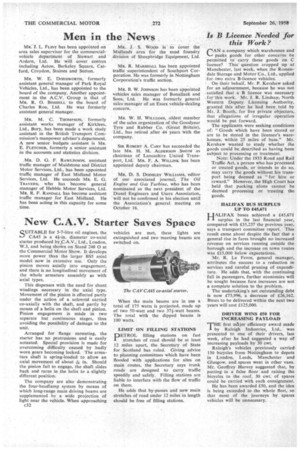New C.A.V. Starter Saves Space
Page 98

If you've noticed an error in this article please click here to report it so we can fix it.
QUITABLE for 5-7-litre oil engines, the Ps-) CA45 is a 44-in, diameter co-axial starter produced by C.A.V., Ltd., London, W.3, and being shown on Stand 248 0 at the Commercial Motor Show. It develops more power than the larger BSS axial model now in extensive use. Only the pinion moves axially into engagement, and there is no longitudinal movement of the whole armature assembly as with axial types.
This dispenses with the need for shunt windings necessary in the axial type. Movement of the pinion is effected partly under the action of a solenoid carried -co-axially with -the shaft, and partly by means of a helix on the shaft and pinion. Pinion engagement is made in two separate but continuous stages, thus avoiding the possibility of damage to the unit.
Arranged for flange mounting, the starter has no protrusions and is easily actuated. Special provision is made for overcoming difficulty caused by badly worn gears becoming locked. The armature shaft is spring-loaded to allow an axial movement of about 116 in. Should the pinion fail to engage, the shaft slides back and turns in the helix to a slightly different position.
The company are also demonstrating the four-headlamp system by means of which long-range main driving beams are supplemented by a • wide projection of light near the vehicle. When approaching
c32 vehicles are met, these lights are extinguished and two meeting beams are switched on.
When the main beams are in use a total of 175 watts is projected, made up of two 50-watt and two 374-watt beams. The total with the dipped beams is 100 watts.
LIMIT ON FILLING STATIONS DETROL filling stations on fast I stretches of road should be at least 12 miles apart, the Secretary of State for Scotland has ruled. Giving advice to planning committees which have been flooded with applications for sites on main routes, the Secretary says trunk roads are designed to carry traffic speedily and safely. Filling stations are liable to interfere with the flow of traffic on them.
He adds that by-passes and new main stretches of road under 12 miles in length should be free of filling stations.












































































































































































































































































































































